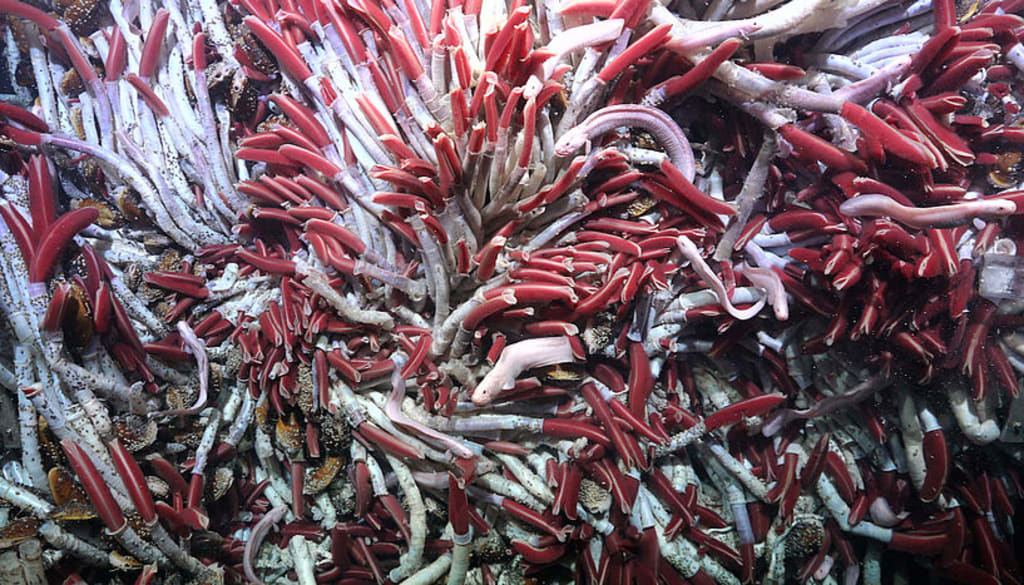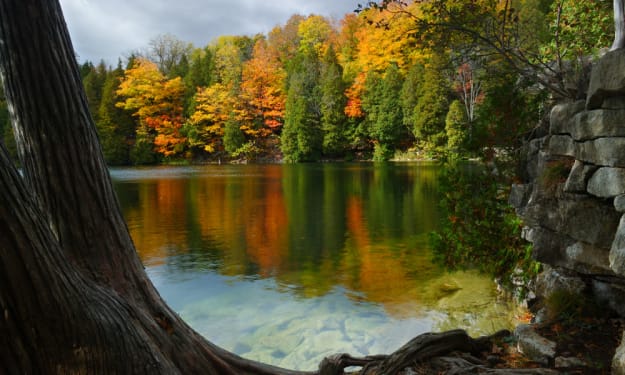HYDROTHERMAL VENTS REVEAL UNIQUE, UNEXPECTED MARINE ECOSYSTEM
Hydrothermal vents are underwater springs that form on the ocean floor. Find out how an international scientific expedition surprised even themselves when they uncovered a new kind of ecosystem beneath one of these formations.

I started snorkelling at a very young age, and I always found underwater swimming in lakes and ponds more enjoyable than doing laps in a concrete pool. There’s something compelling about the underwater world and its inhabitants.
I remember thinking as a young boy that everything seems more graceful underwater. Spending my summers on the edge of Ontario’s Fathom Five National Marine Park was a big bonus for a boy with that attitude.
Life began underwater. Some scientists think it may have originated in geological features on the ocean floor called hydrothermal vents.
HYDROTHERMAL VENTS EMIT MINERAL-RICH HOT WATER
These vents emit mineral-rich hot water into the cold, dark environment at the bottom of the ocean. They form when seawater interacts with magma beneath the Earth’s crust.
There are cracks and crevices in the crusty bottom of the ocean, and cold seawater seeps inside them. The hot molten rock heats the water to over 400˚ C, causing it to jet back into the sea, carrying dissolved minerals and chemicals with it.
When this hot, mineral-rich water mixes with the cold seawater, all sorts of chemical reactions can take place. This is one possible way the complex organic molecules essential to life may have formed.
ROBERT BALLARD MADE FIRST DISCOVERY IN 1977
The first discovery of a hydrothermal vent system came in 1977 when Dr. Robert Ballard found the Galapagos Rift in the eastern Pacific Ocean. His team relied on a remote operated vehicle (ROV) and these robotic submarines have been crucial to finding more of these systems throughout the world’s oceans.
Dr. Monika Bright is a professor of marine biology at the University of Vienna. For over thirty years, she’s been studying ecosystem biodiversity in dark places where plants get their energy from chemicals instead of light.
She’s also interested in ecological relationships where two species share spaces and benefit from one another. These relationships are crucial in extreme environments like hydrothermal vents.
EXPEDITION DISCOVERED NEW ECOSYSTEM OFF PANAMA COAST
Last month, Professor Bright led a research expedition that discovered a new ecosystem beneath the surface of a hydrothermal vent system called the the East Pacific Rise off Panama’s Pacific coast.
The creatures that live in this harsh environment are highly adapted to both the dark and to cold temperatures. They can include giant tube worms, various shellfish, octopuses and specialized fish like the eelpout and snailfish.
The research team included members from Germany, the Netherlands, France, Slovenia, Costa Rica and the US. They lived at sea aboard the Royal Netherlands Institute for Sea Research vessel, Falkor (too).
ROV CARRIED OUT MOST EXPLORATION WORK
As with other hydrothermal vent studies, they relied on an ROV to carry out most of their exploration work. The underwater robot SuBastian from the Schmidt Ocean Institute (SOI) performed a range of exploratory tasks under the scientists’ control.
The team ordered SuBastian to flip over some parts of the sea bed’s volcanic crust. The ROV revealed a previously unknown habitat teeming with worms, snails and specialized bacteria living in pleasantly warm 25˚ C water.
“With this discovery, our understanding of animal life in deep-sea hydrothermal vents has significantly expanded,” Professor Bright explains. “There are two dynamic habitats within the vents. Animals above and below the Earth’s surface thrive together, depending on thermal fluid from below and oxygen from the seawater above.”
RESEARCHERS HELPED ECOSYSTEM TO FLOURISH
The researchers had helped this tiny ecosystem to emerge. SuBastian attached boxes to cracks in the volcanic crust, sealing off each edge, and then left the boxes alone for a few days.
Then, SuBastian returned and removed the boxes. After that, it lifted and flipped over the rock section where the boxes had been resting.
To the researchers’ surprise, the area now hosted large numbers of adult sea creatures. Scientists had known that unique ecosystems quickly spring up around new hydrothermal vents for some time, but their experiment attracted far more biodiversity than they’d expected.
MAJOR INSIGHTS INTO HOW SPECIES COLONIZE HYDROTHERMAL VENTS
These new observations provide fresh, unexpected insights into how species quickly colonize hydrothermal vent environments. The researchers will be analyzing the expedition’s data for the next few months.
We sometimes think there’s nothing new to explore on Earth. Yet, the ocean floor can still surprise us.
Discovering a brand new ecosystem category enables scientists to examine previously unknown species and how they thrive in this bizarre, extreme environment. Once the findings and results have been reviewed and documented, they may challenge our understanding of ocean environments or even guide our search for life on other planets.
AND ANOTHER THING…
Finding this new ecosystem closes some gaps in the new story humanity needs about the world around us and our place within it. Seeing a colony of interdependent creatures emerge in such a harsh, strange location reminds us of the web of life’s interrelatedness.
The discovery also reminds us of the adaptability, complexity and diversity of living things. Through the splendour of evolution, living things can flourish, occupying tiny niches even in our planet’s most bizarre nooks and crannies.
Even the researchers, who’ve devoted their lives to studying marine species, found themselves overcome with a sense of awe and astonishment by this unexpected ecosystem. If they can continue to embrace the beauty and mystery of our planet, we should all share in their sense of wonder.
“I’m not thinking of other planets and moons — I’m thinking that there’s so much mystery to be discovered in our Earth,” Professor Bright told the New York Times. “I feel like I know this place. I’ve studied this place for 30 years. And still, you can find something unexpected.”
We always have more to learn if we dare to know.
Learn more:
Under a Hellish Ocean Habitat, Bizarre Animals Are LurkingStrange Ecosystem Found Thriving below Seafloor Hydrothermal Vents
Cell Origins Revealed by Their Membranes
Animal Origins Revealed by Rethinking Fossil Record
Earth’s Inner Core Falling Behind Planet’s Rotation
About the Creator
David Morton Rintoul
I'm a freelance writer and commercial blogger, offering stories for those who find meaning in stories about our Universe, Nature and Humanity. We always have more to learn if we Dare to Know.






Comments
There are no comments for this story
Be the first to respond and start the conversation.